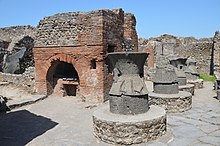Baking in ancient Rome
Baking was a popular profession and source of food in ancient Rome. Many ancient Roman baking techniques were developed due to Greek bakers who traveled to Rome following the Third Macedonian War (171–168 BC). Ancient Roman bakers could make large quantities of money. This may have contributed to receiving a negative reputation. Bakers used tools such as the fornax, testum, thermospodium, and the clibanus to make bread. Most Roman breads were made using sourdough. The most common way to leaven bread was using flour mixed with grain.
History

The Romans had eaten porridge and baked bread for around six hundred years after the founding of Rome. In 171 BC, during the Third Macedonian War, the arrival of Greek bakers established the first professional bakers, known as the pistores, in Rome.[1] It was in ancient Rome where bread and pastries first began to be mass produced.[2]
Process

Ingredients
Ancient Roman bread was typically made from sourdough. White raised bread was preferred over unleavened bread; the latter was associated with the lower classes. Sourdough bread was made by mixing flour with water, and leaving the mix in the open air, to be colonised by wild, airborne yeasts. If this "starter" was successful, a small amount was retained uncooked, to be added to the next batch. The rest was baked. A good starter was handled with care. It could be re-used indefinitely, and, as much as the flour itself, determined the quality of the bread. Other, less popular leavening agents included soured barley cakes, beer foam, or fermented grape juice.[10] Ash cake was the ancient Roman term for food produced in the ashes of a fire. This type of food may be the ancestor of Italian flatbread focaccia.[3] Many baked goods included large quantities of honey and oil.[2] Leaves were used to flavor the bread.[11] The Romans adopted a Gaulic technique of adding froth to bread dough to make light leavened bread.[12]
Equipment
The furnus was developed by the end of the Republic and spread due to a greater need for baking.

Reputation
There is evidence that baking was widespread in ancient Rome. Archaeologists have found over thirty commercial bakeries in Pompeii. Bakers could be identified through imagery such as millstones or donkeys.[3] Wealthy Romans would purchase domestic slaves and use them as bakers. This was seen as a sign of aristocratic status. Bakers were also associated with servility. Cicero considered baking to be a lowly occupation. In Plautus' Poenulus bakers were said to work with prostitutes. Augustus was mocked for being the descendant of an African baker. The negativity towards bakers was likely influenced by the large quantities of wealth bakers would assume.[19]
See also
References
- ^ ISBN 978-0-472-12225-7.
- ^ ISBN 978-0-471-46427-3.
- ^ ISBN 978-1-5267-5751-7.
- ^ S2CID 162321943.
- ISBN 978-1-907087-47-9.
- ISBN 978-90-04-47503-8.
- ISBN 978-3-11-060493-1.
- ISBN 978-1-4408-4693-9.
- ISBN 978-1-61069-403-2.
- ISBN 978-0-19-938113-5. Retrieved 2023-01-01.
- Cambridge Core.
- ISBN 978-1-119-74499-3.
- ISBN 978-1-118-37267-8.
- ISBN 978-0-19-933089-8.
- ISBN 978-0-313-33204-3.
- ^ ISBN 978-0-313-08689-2.
- ISBN 978-0-313-33003-2.
- ISBN 978-1-4738-1775-3.
- ISBN 978-1-4051-7935-5.
